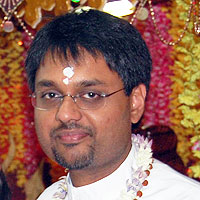From a satsang with Pt. Umesh Persad, Spiritual Leader, SWAHA Gyaan Deepak Kirtan Mandali
Sanatan Dharma teaches us that the function of a mother is to protect, to love and to sustain. These three functions together form Maataa, mother. Sanatan Dharma also states that there are seven entities who we should consider as mothers. According to Chanyak Maharaj, there is a saying, “Aatma Maataa, Guruhu Patni, Brahmani, Raja Patnika, Dehnoor, Dhaatri, Tatha Prithvi, Saptiataa Maataara Smritah”.
The first is Aatmaa Maataa, the biological mother. We all exist because of our mother, and father. We were each formed inside of the mother’s body. The word, Ma, in Sanskrit is that principle of containment or atmosphere that also provides nourishment. We owe a debt of gratitude to our biological mothers because of everything they have given to us, including this body and this life. Mother is the embodiment of Durga, Lakshmi and Saraswati. Durga represents ‘willpower’ and she imparts dharma (righteous living) to us. By her efforts and influence, she shapes us into who we are. As Lakshmi, she gives us the resources we need, from milk as babies, to food, clothing and education; and she protects and sustains us. As Saraswati, she educates us about life. Our biological mothers are always looking after our welfare throughout our lives.
The second mother is Guru patni, the spiritual teacher’s wife. She also sustains us, protects us and gives us knowledge.
The third mother, Brahmani, is the wife of a Brahmin. She is that person who has all the good qualities and is living a good life.
The fourth, Raja patnika, is the king or ruler’s wife. They too are leaders and their function is to serve as role models for organizations, countries and societies.
The fifth is Dhenoor, the cow. In modern times, with some exceptions, Hindus no longer take care of cows, as they once did in ancient times. Cows fulfil the function of mother: they give us sustenance, milk and dahee. All the products of the cow, even the dung and urine, are used for some beneficial purpose. The cow is symbolic of Sanatan Dharma itself: its four legs symbolize four main principles in life, satyam (truth), soucham (cleanliness or purity), dayaa (compassion) and daan (charity). Just as the cow is tied so that it does not wander off, we must also restrain our mind and senses. A cow also has four stomachs, with a complicated digestion process that is called chewing the cud and a tail that flicks away negativities such as insects.
Similarly, all our experiences in the world are processed by our mind. The mind has four functions: manas (mind), buddhi (intelligence), chit (consciousness) and ahankaar (ego). They also indicate the way that we analyze and process knowledge: pratyaksha (perception), anumaan (inference), upamaan (comparison) and shabda (verbal testimony). In Sanatan Dharma, we also have four means of spiritual advancement: contemplation, prayer, meditation and revelation. This is why we give the cow as charity, gow daan. This represents giving up attachments and desires and achieving control over the self.
The sixth mother is Dhaatri, a nurse or any woman who functions in a caregiver role. They are associated with nurturing and healing, qualities that we associate with a mother.
The seventh mother is Prithvi, the Earth. We are all protected by the atmosphere. Everything we need for nourishment and sustenance is in the Earth. Unfortunately, we are destroying it. We need to respect the Earth as a mother and be grateful for her bounty.
These seven mothers need to be understood, loved and respected. In the month of May, as we celebrate Mother’s Day, we must continue to demonstrate our love and gratitude to our mothers.



